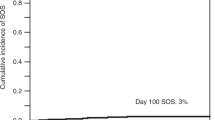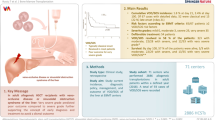Abstract
Sinusoidal obstruction syndrome (SOS) is a lethal complication after hematopoietic stem cell transplantation (HSCT). Defibrotide (DF) is the only drug internationally recommended for SOS treatment in Western countries. Recombinant human soluble thrombomodulin (rhTM), which is promising for the treatment of patients with disseminated intravascular coagulation, is also reported to be potentially effective for SOS. To clarify the safety and efficacy of DF and rhTM, we conducted a retrospective survey of these agents in Japan. Data from 65 patients who underwent allogeneic HSCT and received DF (n = 24) or rhTM (n = 41) for SOS treatment were collected. The complete response rates for SOS on day 100 were 50% and 54% in the DF and rhTM groups, respectively. The 100-day overall survival rates were 50% in the DF group, and 48% in the rhTM group. Several severe hemorrhagic adverse events were observed in one patient in the DF group and five patients in the rhTM group. The main causes of death were SOS-related death, and no patient died of direct adverse events of DF or rhTM. Our results suggest that rhTM, as well as DF, can be effective as a novel treatment option for SOS.
This is a preview of subscription content, access via your institution
Access options
Subscribe to this journal
Receive 12 print issues and online access
$259.00 per year
only $21.58 per issue
Buy this article
- Purchase on Springer Link
- Instant access to full article PDF
Prices may be subject to local taxes which are calculated during checkout

Similar content being viewed by others
References
Carreras E, Diaz-Beya M, Rosinol L, Martinez C, Fernandez-Aviles F, Rovira M. The incidence of veno-occlusive disease following allogeneic hematopoietic stem cell transplantation has diminished and the outcome improved over the last decade. Biol Blood Marrow Transplant. 2011;17:1713–20.
Coppell JA, Richardson PG, Soiffer R, Martin PL, Kernan NA, Chen A, et al. Hepatic veno-occlusive disease following stem cell transplantation: incidence, clinical course, and outcome. Biol Blood Marrow Transplant. 2010;16:157–68.
Dalle JH, Giralt SA. Hepatic veno-occlusive disease after hematopoietic stem cell transplantation: Risk factors and stratification, prophylaxis, and treatment. Biol Blood Marrow Transplant. 2016;22:400–9.
Corbacioglu S, Richardson PG. Defibrotide for children and adults with hepatic veno-occlusive disease post hematopoietic cell transplantation. Expert Rev Gastroenterol Hepatol. 2017;11:885–98.
Mohty M, Malard F, Abecassis M, Aerts E, Alaskar AS, Aljurf M, et al. Sinusoidal obstruction syndrome/veno-occlusive disease: current situation and perspectives-a position statement from the European Society for Blood and Marrow Transplantation (EBMT). Bone Marrow Transplant. 2015;50:781–9.
Mohty M, Malard F, Abecassis M, Aerts E, Alaskar AS, Aljurf M, et al. Revised diagnosis and severity criteria for sinusoidal obstruction syndrome/veno-occlusive disease in adult patients: a new classification from the European Society for Blood and Marrow Transplantation. Bone Marrow Transplant. 2016;51:906–12.
Yakushijin K, Atsuta Y, Doki N, Yokota A, Kanamori H, Miyamoto T, et al. Sinusoidal obstruction syndrome after allogeneic hematopoietic stem cell transplantation: Incidence, risk factors and outcomes. Bone Marrow Transplant. 2016;51:403–9.
Palmer KJ, Goa KL. Defibrotide. A review of its pharmacodynamic and pharmacokinetic properties, and therapeutic use in vascular disorders. Drugs. 1993;45:259–94.
Dignan FL, Wynn RF, Hadzic N, Karani J, Quaglia A, Pagliuca A, et al. BCSH/BSBMT guideline: diagnosis and management of veno-occlusive disease (sinusoidal obstruction syndrome) following haematopoietic stem cell transplantation. Br J Haematol. 2013;163:444–57.
Al Jefri AH, Abujazar H, Al-Ahmari A, Al Rawas A, Al Zahrani Z, Alhejazi A, et al. Veno-occlusive disease/sinusoidal obstruction syndrome after haematopoietic stem cell transplantation: Middle East/North Africa regional consensus on prevention, diagnosis and management. Bone Marrow Transplant. 2017;52:588–91.
Richardson PG, Riches ML, Kernan NA, Brochstein JA, Mineishi S, Termuhlen AM, et al. Phase 3 trial of defibrotide for the treatment of severe veno-occlusive disease and multi-organ failure. Blood. 2016;127:1656–65.
Corbacioglu S, Carreras E, Mohty M, Pagliuca A, Boelens JJ, Damaj G, et al. Defibrotide for the treatment of hepatic veno-occlusive disease: Final results from the international compassionate-use program. Biol Blood Marrow Transplant. 2016;22:1874–82.
Maruyama I. Recombinant thrombomodulin and activated protein C in the treatment of disseminated intravascular coagulation. Thromb Haemost. 1999;82:718–21.
Saito H, Maruyama I, Shimazaki S, Yamamoto Y, Aikawa N, Ohno R, et al. Efficacy and safety of recombinant human soluble thrombomodulin (ART-123) in disseminated intravascular coagulation: results of a phase III, randomized, double-blind clinical trial. J Thromb Haemost. 2007;5:31–41.
Vincent JL, Ramesh MK, Ernest D, LaRosa SP, Pachl J, Aikawa N, et al. A randomized, double-blind, placebo-controlled, Phase 2b study to evaluate the safety and efficacy of recombinant human soluble thrombomodulin, ART-123, in patients with sepsis and suspected disseminated intravascular coagulation. Crit Care Med. 2013;41:2069–79.
Hayakawa M, Yamakawa K, Saito S, Uchino S, Kudo D, Iizuka Y, et al. Recombinant human soluble thrombomodulin and mortality in sepsis-induced disseminated intravascular coagulation. A multicentre retrospective study. Thromb Haemost. 2016;115:1157–66.
Ikezoe T, Togitani K, Komatsu N, Isaka M, Yokoyama A. Successful treatment of sinusoidal obstructive syndrome after hematopoietic stem cell transplantation with recombinant human soluble thrombomodulin. Bone Marrow Transplant. 2010;45:783–5.
Ohwada C, Takeuchi M, Kawaguchi T, Tsukamoto S, Sakai S, Takeda Y, et al. Successful treatment with recombinant soluble thrombomodulin of two cases of sinusoidal obstructive syndrome/hepatic veno-occlusive disease after bone marrow transplantation. Am J Hematol. 2011;86:886–8.
Nakamura D, Yoshimitsu M, Kawada H, Inoue H, Kuroki T, Kaieda T, et al. Recombinant human soluble thrombomodulin for the treatment of hepatic sinusoidal obstructive syndrome post allogeneic hematopoietic SCT. Bone Marrow Transplant. 2012;47:463–4.
Yamamoto S, Yagawa A, Toyama D, Akiyama K, Hayashi M, Mabuchi M, et al. Successful treatment of hepatic sinusoidal obstructive syndrome after hematopoietic stem cell transplantation in a child using recombinant thrombomodulin. Acta Haematol. 2013;129:62–4.
Inagaki J, Kurauchi K, Fukano R, Noguchi M, Okamura J. Heterogeneous response to recombinant thrombomodulin by grade of sinusoidal obstructive syndrome after pediatric stem cell transplantation. Bone Marrow Transplant. 2016;51:1543–5.
Kanda Y. Investigation of the freely available easy-to-use software ‘EZR’ for medical statistics. Bone Marrow Transplant. 2013;48:452–8.
Ikezoe T. Thrombomodulin/activated protein C system in septic disseminated intravascular coagulation. J Intensive Care. 2015;3:1.
Richardson PG, Soiffer RJ, Antin JH, Uno H, Jin Z, Kurtzberg J, et al. Defibrotide for the treatment of severe hepatic veno-occlusive disease and multiorgan failure after stem cell transplantation: a multicenter, randomized, dose-finding trial. Biol Blood Marrow Transplant: J Am Soc Blood Marrow Transplant. 2010;16:1005–17.
Hayakawa M, Kushimoto S, Watanabe E, Goto K, Suzuki Y, Kotani T, et al. Pharmacokinetics of recombinant human soluble thrombomodulin in disseminated intravascular coagulation patients with acute renal dysfunction. Thromb Haemost. 2017;117:851–9.
Corbacioglu S, Greil J, Peters C, Wulffraat N, Laws HJ, Dilloo D, et al. Defibrotide in the treatment of children with veno-occlusive disease (VOD): a retrospective multicentre study demonstrates therapeutic efficacy upon early intervention. Bone Marrow Transplant. 2004;33:189–95.
Richardson PG, Smith AR, Triplett BM, Kernan NA, Grupp SA, Antin JH, et al. Earlier defibrotide initiation post-diagnosis of veno-occlusive disease/sinusoidal obstruction syndrome improves Day +100 survival following haematopoietic stem cell transplantation. Br J Haematol. 2017;178:112–8.
Bearman SI, Lee JL, Baron AE, McDonald GB. Treatment of hepatic venocclusive disease with recombinant human tissue plasminogen activator and heparin in 42 marrow transplant patients. Blood. 1997;89:1501–6.
Tsubokura M, Yamashita T, Inagaki L, Kobayashi T, Kakihana K, Wakabayashi S, et al. Fatal intracranial hemorrhage following administration of recombinant thrombomodulin in a patient after cord blood transplantation. Bone Marrow Transplant. 2011;46:1030–1.
Acknowledgements
We would like to thank all patients and their families in our study, the medical staffs in the participating centers, and collaborators Dr. Nozomu Kawashima (Nagoya University Hospital), Dr. Kai Yamasaki (Osaka City General Hospital), Dr. Yuichi Kato (Yamagata University Hospital), Dr. Hideo Yagi (Kindai University Nara Hospital), Dr. Shotaro Tatekawa (Konan Kosei Hospital), Dr. Taichi Ikebe (Oita University Hospital), and Dr. Yoshihisa Morishita (Konan Kosei Hospital).
Author information
Authors and Affiliations
Corresponding author
Ethics declarations
Conflict of interest
KY received honoraria from Asahi-kasei Pharma, JAZZ Pharmaceuticals, and Pfizer Inc. TI received grant/research support from Asahi-kasei Pharma. YU received research funding and travel expense fee from Kainos Laboratories Inc., Ablynx NV., and Eli Lilly Japan, outside submitted work. AK received grant/research support from JAZZ Pharmaceuticals and Nippon Shinyaku Co., Ltd. The remaining authors declare that they have no conflict of interest.
Rights and permissions
About this article
Cite this article
Yakushijin, K., Ikezoe, T., Ohwada, C. et al. Clinical effects of recombinant thrombomodulin and defibrotide on sinusoidal obstruction syndrome after allogeneic hematopoietic stem cell transplantation. Bone Marrow Transplant 54, 674–680 (2019). https://doi.org/10.1038/s41409-018-0304-4
Received:
Revised:
Accepted:
Published:
Issue Date:
DOI: https://doi.org/10.1038/s41409-018-0304-4
This article is cited by
-
HokUS-10 scoring system predicts the treatment outcome for sinusoidal obstruction syndrome after allogeneic hematopoietic stem cell transplantation
Scientific Reports (2023)
-
Utility of liver stiffness measurement in the diagnosis of sinusoidal obstruction syndrome/veno-occlusive disease after hematopoietic stem cell transplantation
Journal of Medical Ultrasonics (2023)
-
Advances in the diagnosis and treatment of disseminated intravascular coagulation in haematological malignancies
International Journal of Hematology (2021)
-
Defibrotide/thrombomodulin-alfa
Reactions Weekly (2019)



